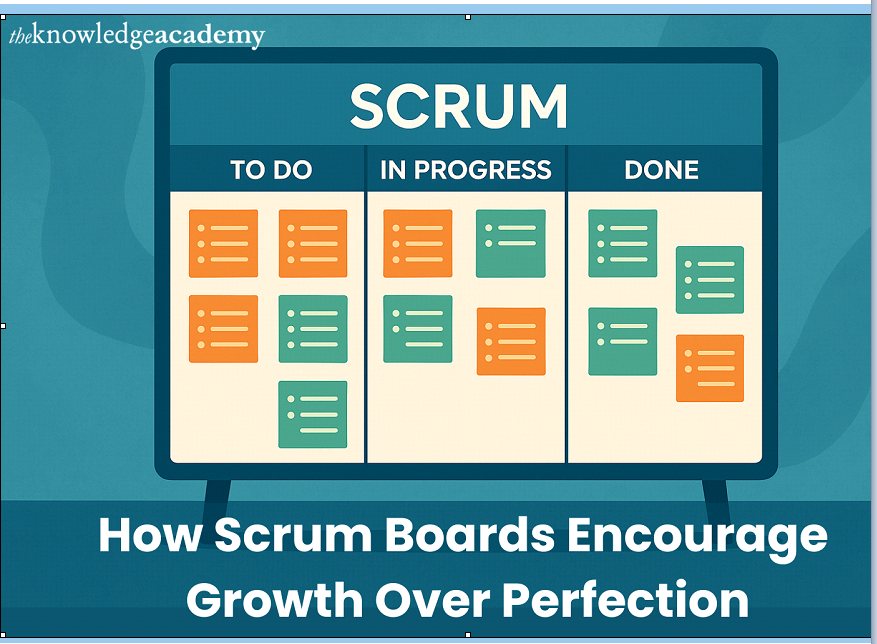Have you ever been stuck trying to perfect every task on your to-do list? The pursuit of perfection can sometimes slow us down more than we realise, especially in fast-paced team environments. Instead of aiming for flawless outcomes, what if we focused on consistent progress?
A Scrum Master Course can teach you how to embrace growth over perfection, and this mindset starts with tools like the Scrum Board. These boards are designed to help teams visualise work, adapt, and continually improve, providing a clear path forward without the pressure of perfect execution. Let’s explore how scrum boards encourage growth over perfection.
Table of Contents
⦁ What is a Scrum Board
⦁ How Scrum Boards Shift the Focus to Growth
⦁ The Role of Visualisation in Team Development
⦁ Scrum Boards and Continuous Improvement
⦁ Conclusion
What is a Scrum Board
At its core, a Scrum board is a visual tool that represents a team’s workflow throughout a Sprint. It helps team members track what has been completed, what’s currently in progress, and what still needs to be done. Typically divided into columns such as “To Do,” “In Progress,” and “Done,” Scrum boards can be either physical or digital, depending on the team’s preference.
Scrum boards are designed to be adaptable, allowing them to evolve with the team’s needs rather than being rigid tools for task management. They enable teams to focus on the flow of work, highlighting areas of progress and identifying areas for improvement rather than striving for perfection.
How Scrum Boards Shift the Focus to Growth
One of the foundational principles of Scrum is its iterative nature. Teams work in small, time-boxed increments called Sprints. Each Sprint concludes with a review, during which the team reflects on what went well, what didn’t, and how they can improve for the next iteration. Scrum boards play a vital role in this process by providing teams with a tangible way to track and monitor their development over time.
Rather than fixating on delivering a perfect product, Scrum boards encourage teams to aim for a potentially shippable product at the end of each Sprint. The focus shifts from perfection to continuous development, fostering a mindset prioritising learning and growth over fear of making mistakes. This approach helps teams reflect, adapt, and grow with every iteration, ensuring constant change and improvement.
The Scrum board concept is built around the idea that change is constant. As tasks evolve and unexpected challenges arise, the board can be updated, reflecting the team’s adaptability. The team isn’t judged on how flawless its work is at the end of each Sprint; it’s evaluated on its ability to reflect, adapt, and improve with each iteration.
The Role of Visualisation in Team Development
Scrum boards are powerful tools for visualising work and fostering transparency within a team. By making tasks visible, team members can see the flow of work, promoting collaboration and open communication. This visual representation underscores that the process is as important as the outcome.
Visualisation also helps teams quickly identify areas where work may be stalled or obstacles that need attention. This visibility enables teams to address issues in their regular Scrum meetings and work together to find solutions. The sense of shared responsibility encourages collaboration and drives continuous improvement.
Moving tasks from “In Progress” to “Done” provides a sense of achievement, and this visual tracking shifts the team’s focus from perfectionism to progress. Team members learn to concentrate on completing tasks and learning from them rather than striving for perfection in every assignment.
Scrum Boards and Continuous Improvement
One of the most powerful aspects of Scrum boards is how they foster continuous improvement. Scrum boards are integral to inspecting and adapting, which is central to Scrum. They help teams reflect at the end of each Sprint, providing a clear visual representation of completed and unfinished tasks so teams can assess their development and identify areas that need attention.
When something doesn’t go as planned, the Scrum board helps teams focus on understanding the cause and how they can grow in the next Sprint rather than assigning blame. Scrum boards support ongoing development by encouraging teams to embrace mistakes, learn from them, and continuously refine their processes. The focus is on adapting to change, promoting experimentation and risk-taking.
Conclusion
Scrum boards are more than just a tool for managing tasks; they reflect Scrum’s core values of flexibility, collaboration, and continuous improvement. Scrum boards help teams become more adaptable, creative, and productive by shifting the focus from perfection to growth. Consider The Knowledge Academy courses to advance your knowledge of Scrum and the techniques that make it work.


